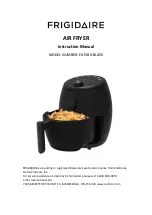
11
Determine vent length and elbows needed for best
drying performance
■
Use the following Vent system chart to determine type of vent
material and hood combinations acceptable to use.
■
NOTE: Do not use vent runs longer than those specified in
the Vent system chart. Exhaust systems longer than those
specified will:
■
Shorten the life of the dryer.
■
Reduce performance, resulting in longer drying times and
increased energy usage.
The Vent system chart provides venting requirements that will
help to achieve the best drying performance.
Vent system chart
NOTE: Side and bottom exhaust installations have a 90º turn
inside the dryer. To determine maximum exhaust length, add one
90º turn to the chart.
Install Vent System
1. Install exhaust hood. Use caulking compound to seal exterior
wall opening around exhaust hood.
2. Connect vent to exhaust hood. Vent must fit inside exhaust
hood. Secure vent to exhaust hood with 4" (10.2 cm) clamp.
3. Run vent to dryer location. Use the straightest path possible.
See “Determine vent path” in “Plan Vent System.” Avoid 90º
turns. Use clamps to seal all joints. Do not use duct tape,
screws or other fastening devices that extend into the interior
of the vent to secure vent.
Connect Inlet Hose
The dryer must be connected to the cold water faucet using the
new inlet hoses. Do not use old hoses.
1. Turn cold water faucet off and remove washer inlet hose.
2. Remove old rubber washer from inlet hose and replace with
new rubber washer provided. If space permits, attach the
brass female end of the “Y” connector to the cold water
faucet.
NOTE: If “Y” connector can be attached directly to cold water
faucet, go to Step 6. If “Y” connector cannot be attached
directly to the cold water faucet, the short hose must be
used. Continue with Step 3.
3. Attach short hose to cold water faucet. Screw on coupling by
hand until it is seated on faucet.
4. Using pliers, tighten the couplings with an additional two-
thirds turn.
NOTE: Do not overtighten. Damage to the coupling can
result.
5. Attach “Y” connector to brass male end of small hose. Screw
on coupling by hand until it is seated on connector.
6. Attach straight end of long hose to “Y” connector.
7. Attach washer cold inlet hose to other end of “Y” connector.
Screw on coupling by hand until it is seated on connector.
8. Using pliers, tighten the couplings with an additional two-
thirds turn.
NOTE: Do not overtighten. Damage to the coupling can
result.
9. Attach angled end of long hose to fill valve at bottom of dryer
back panel. Screw on coupling by hand until it is seated on fill
valve connector.
10. Using pliers, tighten the coupling with an additional two-
thirds turn.
NOTE: Do not overtighten. Damage to the coupling can
result.
11. Check that the water faucets are on.
12. Check for leaks around “Y” connector, faucet and hoses.
Number of
90º turns
or elbows
Type of
vent
Box or
Louvered
hoods
Angled
hoods
0
Rigid metal
Flexible metal
64 ft (20 m)
36 ft (11 m)
58 ft (17.7 m)
28 ft (8.5 m)
1
Rigid metal
Flexible metal
54 ft (16.5 m)
31 ft (9.4 m)
48 ft (14.6 m)
23 ft (7 m)
2
Rigid metal
Flexible metal
44 ft (13.4 m)
27 ft (8.2 m)
38 ft (11.6 m)
19 ft (5.8 m)
3
Rigid metal
Flexible metal
35 ft (10.7 m)
25 ft (7.6 m)
29 ft (8.8 m)
17 ft (5.2 m)
4
Rigid metal
Flexible metal
27 ft (8.2 m)
23 ft (7 m)
21 ft (6.4 m)
15 ft (4.6 m)
A. Inlet to cold water
A
Summary of Contents for 110.C9772 Series
Page 26: ...26 Notes ...
Page 54: ...54 Notes ...












































